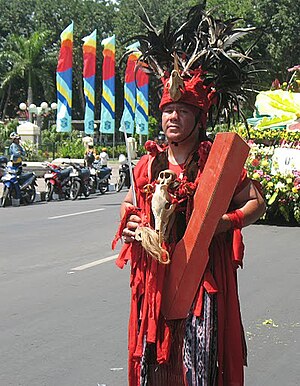 | |
| Total population | |
|---|---|
| c. 1.4 million | |
| Regions with significant populations | |
| Indonesia (North Sulawesi, Jabodetabekpunjur, East Java, South Sulawesi, East Kalimantan, Central Sulawesi, Papua) Overseas (United States, Malaysia, Philippines, United Kingdom, Singapore, Netherlands) | |
| Languages | |
| Minahasan languages, Manado Malay, Indonesian | |
| Religion | |
| Christianity 93% (Protestantism (85%), Roman Catholicism (7%)), Sunni Islam (8%)[1] | |
| Related ethnic groups | |
| Mongondow people, Gorontaloan people, Visayans |
The Minahasans or Minahassa are an indigenous ethnic group from the North Sulawesi province of Indonesia, formerly known as North Celebes. The Minahasa people sometimes refer to themselves as Manado people. Although the Minahasan pre-Christian creation myth entails some form of ethnic unification,[2] before the nineteenth century the Minahasa region was in no way unified. Instead, a number of politically independent groups (walak) existed together, often in a permanent state of conflict.[3]
Minahasans are the most populous ethnic group in the Minahasan peninsula of North Sulawesi, a Christian-majority region in a Muslim-majority country (Indonesia). The indigenous inhabitants of Minahasa are 'Austronesian' people who are the descendants of earlier migrations from further North. Prior to contact with Europeans, people living in the Minahasan peninsula primarily had contact with the people of North Maluku and with Chinese and Malay traders from within the Indonesian archipelago. From the 1500s onwards, the region had contact with the Portuguese and Spanish. Ultimately, however, it was the Dutch who colonized the region; firstly through the Dutch East India Company (VOC) and, from 1817 onwards, through the administration of the Dutch nation state.[4]
There are nine languages that are indigenous to the Minahasan peninsula. All languages belong to the Malayo-Polynesian branch of the Austronesian language family, and five of these (Tondano, Tombulu, Tonsea, Tontemboan, and Tonsawang) comprise the Minahasan microgroup, while three (Bantik, Toratan, and Sangir) are part of the Sangiric group.[5] Another language (Ponosakan) is considered moribund and is part of the Gorontalo-Mongondow microgroup.[6] The language of wider communication, Manado Malay (also known as Minahasa Malay), contains numerous loan words from Spanish, Portuguese, and Dutch - a result of contact with European powers from 1523 onwards.[3] While Manado Malay bears some similarities with other varieties of Malay spoken in eastern Indonesia, it also displays many differences.[7] It has been termed both a creole language and a dialect or variety of Malay.[8][9]
Minahasa Raya is the area covering Bitung City, Manado City, Tomohon City, Minahasa Regency, North Minahasa Regency, South Minahasa Regency and Southeast Minahasa Regency, which are altogether seven of the fifteen regional administrations in the province of North Sulawesi, Indonesia.
Historically, the Minahasa region was located within the sphere of influence of the Ternate Sultanate.[10][11] The links with the Ternate people are evidenced by lexical borrowings from the Ternate language;[12] moreover, Manado Malay originates from North Moluccan Malay (Ternate Malay).[8][13] The Minahasa people, however, resisted Islamization.[9] In the Dutch East Indies the Minahasa people identified strongly with the Dutch language, culture and the Protestant faith – so strongly, in fact, that when Indonesia became independent in 1945 certain factions of political elites of the region even pleaded with the Dutch to let it become a province of the Netherlands.[14] The centuries-old strong bond between the Minahasa and the Netherlands has recently been studied and explained using the Stranger King concept.
There is a considerable number of people from the Minahasa living in the Netherlands, as part of the Indo (Eurasian) community.[15]
- ^ Paul Richard Renwarin, Matuari Wo Tonaas (Jakarta, Indonesia: Penerbit Cahaya Pineleng, 2007), p. 35
- ^ Lundström-Burghoorn, W. 1981. Minahasa civilization: A tradition of change. Gothenburg, Sweden: ACTA Universitatis Gothoburgensis
- ^ a b Schouten, M. J. C. 1983. Leadership and social mobility in a Southeast Asian society: Minahasa, 1677 – 1983. Leiden: KITLV Press
- ^ Schouten, M. J. C. 1983. Leadership and social mobility in a Southeast Asian society: Minahasa, 1677 – 1983. Leiden: KITLV Press
- ^ Blust, R. 2013. The Austronesian languages. Canberra: Asia Pacific Linguistics Open Access Monographs
- ^ Lobel, Jason William (2015). "Ponosakan: A Dying Language of Northeastern Sulawesi". Oceanic Linguistics. 54 (2): 396–435. doi:10.1353/ol.2015.0022. S2CID 146182992.
- ^ Stoel, R. 2005. Focus in Manado Malay: grammar, particles, and intonation. Leiden:CNWS publications
- ^ a b Brickell, Timothy C. (2020). "Language contact in North Sulawesi: Preliminary observations". In Conners, Thomas J.; Utsumi, Atsuko (eds.). Aspects of regional varieties of Malay. NUSA 68. Vol. 68. pp. 159–190. doi:10.15026/94893. OCLC 8682619226.
{{cite book}}:|journal=ignored (help) - ^ a b Gall, Timothy L.; Hobby, Jeneen, eds. (2009). "Minahasans". Worldmark Encyclopedia of Cultures and Daily Life. Vol. 4 (2 ed.). Farmington Hills, MI: Gale. pp. 650–653. ISBN 978-1-4144-4892-3. OCLC 388481759. Archived from the original on 2020-06-04 – via Encyclopedia.com.
- ^ Draeger, Donn (1972), Weapons & Fighting Arts of Indonesia, North Clarendon, VT: Tuttle Publishing, p. 223, ISBN 978-1-4629-0509-6, OCLC 784885662
- ^ Visser, Leontine E. (1989), "Foreign Textiles in Sahu Culture", in Gittinger, Mattiebelle (ed.), To Speak with Cloth: Studies in Indonesian Textiles, Los Angeles: Museum of Cultural History, University of California, pp. 81–90, ISBN 9780930741174, OCLC 20970370
- ^ Henley, David (1993), "A superabundance of centers: Ternate and the contest for North Sulawesi", Cakalele, 4: 39–60, OCLC 773559335
- ^ Bowden, John (December 2005), "Language Contact and Metatypic Restructuring in the Directional System of North Maluku Malay", Concentric: Studies in Linguistics, 31 (2): 133–158, doi:10.6241/concentric.ling.200512_31(2).0006, OCLC 1291812763
- ^ Jacobsen, Michael (2002), "Cross-border Communities and Deterritorialising Identities. Assessing the Diaspora Triangle: Migrant-host-home" (PDF), SEARC Working Paper Series, no. 19, archived from the original (PDF) on 2005-02-22, retrieved 2007-02-14 Document
- ^ Minahassers in Indonesië en Nederland: migratie en cultuurverandering, Menno Hekker, Disertasi Universiteit van Amsterdam, 1993